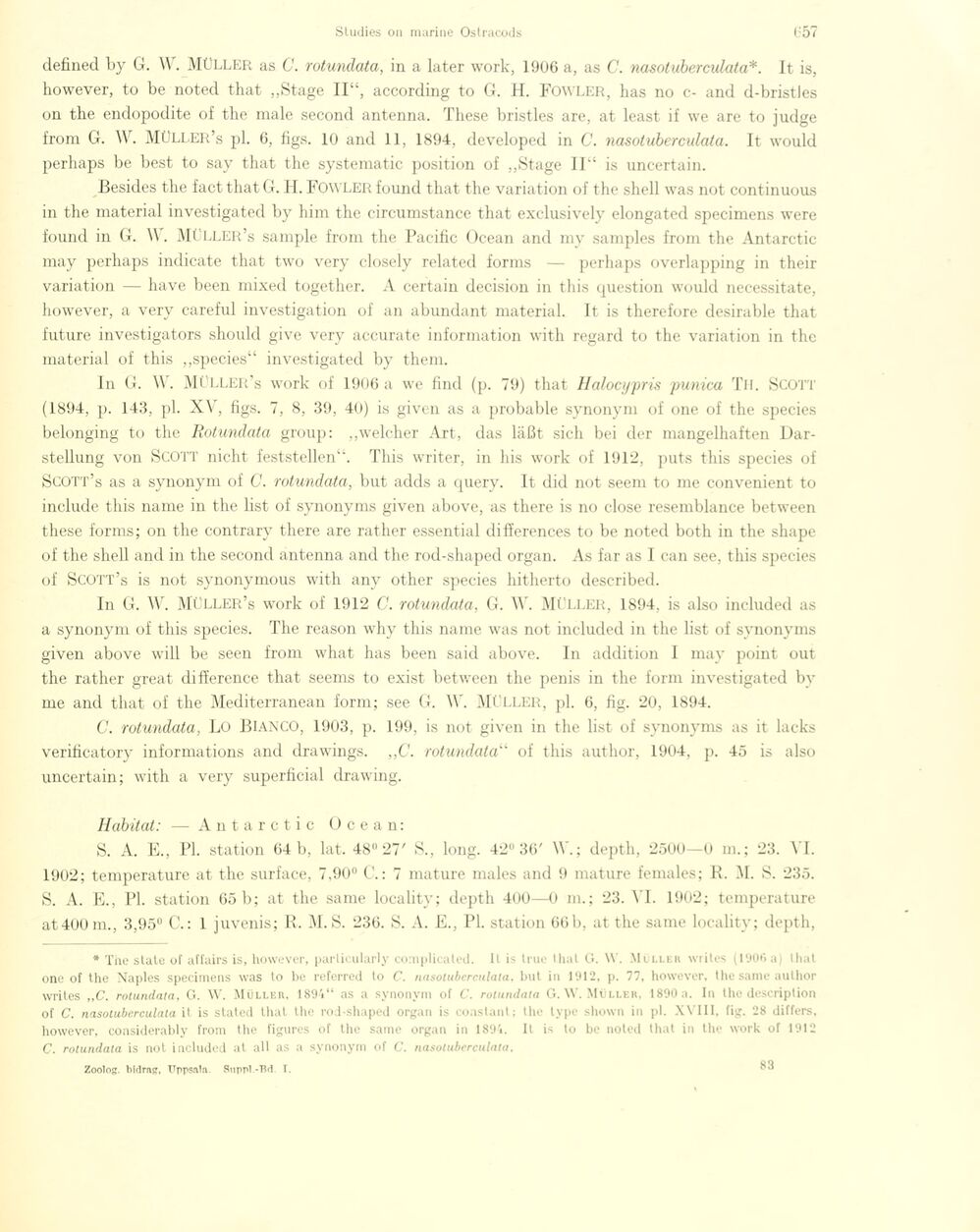
Full resolution (JPEG) - On this page / på denna sida - Sidor ...

<< prev. page << föreg. sida << >> nästa sida >> next page >>
Below is the raw OCR text
from the above scanned image.
Do you see an error? Proofread the page now!
Här nedan syns maskintolkade texten från faksimilbilden ovan.
Ser du något fel? Korrekturläs sidan nu!
This page has never been proofread. / Denna sida har aldrig korrekturlästs.
defined by G. W. Müller as C. rotundata, in a later work, 1906 a, as C. nasotuberculata*. It is,
however, to be noted that „Stage II“, according to G. H. Fowler, lias no c- and d-bristles
on the endopodite of the male second antenna. These bristles are, at least if we are to judge
from G. W. MÜLLER’s pi. 6, figs. 10 and 11, 1894, developed in C. nasotuberculata. It would
perhaps be best to say that the systematic position of „Stage II“ is uncertain.
ßesides the faet that G. H. Fowler found that the variation of the shell was not continuons
in the material investigated by him the circumstance that exelusively elongated specimens were
found in G. \\. MCller’s sample from the Pacific Ocean and my samples from the Antarctic
may perhaps indicate that two very closely related forms — perhaps overlapping in their
variation — have been mixed together. A certain decision in this question would necessitate,
however, a very careful investigation of an abundant material. It is therefore desirable that
future investigators should give very accurate information with regard to the variation in the
material of this „species“ investigated by them.
In G. \\. MÜLLER’s work of 1906 a we find (p. 79) that Halocypris punica Til. SCOTT
(1894, p. 143, pi. X\, figs. 7, 8, 39, 40) is given as a probable synonym of one of the species
belonging to the Rotundata group: „welcher Art, das läßt sich bei der mangelhaften
Darstellung von SCOTT nicht feststellen“. This writer, in liis work of 1912, puts this species of
Scott’s as a synonym of C. rotundata, but adds a qiiery. It did not seem to me convenient to
include this name in the list of synonyms given above, as there is no close resemblance between
these forms; on the contrary there are rather essential differences to be noted both in the shape
of the shell and in the second antenna and the rod-shaped organ. As far as I can see, this species
of Scott’s is not synonymous with any other species hitherto described.
In G. W. MÜLLER’s work of 1912 C. rotundata, G. \V. MÜLLER, 1894, is also included as
a synonym of this species. The reason why this name was not included in the list of synonyms
given above will be seen from what has been said above. In addition I may point out
the rather great difference that seems to exist between the penis in the form investigated by
me and that of the Mediterranean form; see G. W. Müller, pi. 6, fig. 20, 1894.
C. rotundata, Lo BlANCO, 1903, p. 199, is not given in the list of synonyms as it lacks
verificatory informations and drawings. ,,C. rotundata1’1’ of this author, 1904, p. 45 is also
uncertain; with a very superficial dra wing.
Habitat: — Antarctic Ocean:
S. A. E., PI. station 64 b, lat. 48° 27’ S., long. 42° 36’ W.; depth, 2500—0 m.; 23. VI.
1902; temperature at the surface, 7,90° C.: 7 mature males and 9 mature females; R. M. S. 235.
S. A. E., PI. station 65 b; at the same locality; depth 400—0 m.; 23. VI. 1902; temperature
at400 m., 3,95° C.: 1 juvenis; R. M. S. 236. S. A. E„ PI. station 66b, at the same locality; depth,
* The slate oT affairs is, however, parlicularly complica led. Il is true that G. W. Müller writes (1906 a) Ihat
one of the Naples specimens was to be referred to C. nasotuberculata. but in 1912, p. 77, however, the same author
writes „C. rotundata, G. W. Müller, 1894“ as a synonym of C. rotundata G. W. Müller, 1890 a. In the description
of C. nasotuberculata it is stated that the rod-shaped organ is constant; the type shown in pi. XVIII, fig. 28 differs,
however, considerably from the figures of the same organ in 1891. It is to be noted that in the work of 1912
C. rotundata is not included at all as a synonym of C. nasotuberculata.
Zoolog, bidrag, Uppsala. Suppl -Tld I.
89
<< prev. page << föreg. sida << >> nästa sida >> next page >>